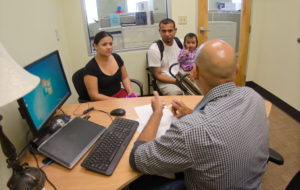Devils (and angels) in the details, Part 4

In early January the California Water Board published its long-anticipated draft proposal for a statewide low-income water bill assistance program. In the past few posts, I’ve summarized the path-breaking proposal, discussed its potentially perverse incentives for ratemaking, and pondered its implications for small system consolidation. In this post, I take up that crucial but oft-overlooked dimension of public policy: administration.
Administering statewide water bill assistance
The draft proposal acknowledges that administering a brand new social welfare transfer program will be costly and complicated. The low-income water rate assistance program will need to be advertised, applications processed, incomes and personal data verified, customers enrolled, and so on. Then the benefits themselves would need to be distributed in some way. Participants will need to renew their eligibility periodically, which will require re-verification. Audit procedures will be needed to guard against fraud and abuse, and appeals processes established to provide recourse to those wrongfully denied benefits.
The draft proposal punts on who exactly would do all that administrative work.
Benefit distribution
Rather than arguing for a specific administrative arrangement, it lays out four potential approaches to benefit disbursement:
- Water bill credits
- Energy bill credits
- EBT (Electronic Benefits Transfer) cards
- Tax credits
The first option might seem most obvious, but the draft report correctly observes that many benefit-eligible households may not receive water bills directly, because they live in multifamily or rental housing and so pay for water service through their rent. Options #2-4 have the potential to reach more households. Options #3 and #4 most closely approximate the received wisdom of welfare research, which suggests that benefits work best when they are received directly by their beneficiaries.
What about everything else?
But there’s much more to a low-income assistance program than handing out benefits. Conspicuously absent from the draft report is discussion of the many other aspects of administering a new assistance program. Here are some options.

Utility administration. Water systems could administer the program on behalf of the state (several California investor-owned utilities already run assistance programs, for example). Utility organizations are, by and large, unaccustomed to administering social welfare programs. Recently I’ve had the opportunity to study a handful of water utilities that administer low-income assistance programs. I found that, when water utilities get into the low-income assistance game, utility staff become de facto social workers. Water customers who apply for assistance often struggle with multiple health, financial, legal, and perhaps cultural problems. It is impossible not to make a human connection in such cases. Laudably, the utility folks I’ve met who administer water assistance programs work hard to do so humanely and responsibly. But welfare administration is, at best, an uneasy fit for many utility organizations. Moreover, the burden of administering an assistance program would be especially onerous for the very small systems that already suffer disproportionately from high prices and poor water quality.
State administration. The California Water Board (or some new agency) could create a new organization to administer the program. This sort of centralized administration could provide economies of scale and help ensure uniformity and fairness across the state. On the other hand, state administration would involve significant new investments in staffing and other administrative infrastructure, all of which would be subject to the vagaries of state politics.
Nonprofit administration. Water bill assistance could be administered through community-based nonprofit community service organizations like the Salvation Army or St Vincent DePaul Society. In addition to providing direct charitable aid, such organizations often are conduits for government assistance programs like LIHEAP. Many of these nonprofit organizations employ sizable, multilingual staffs that include social workers, nutritionists, lawyers, and other professionals who help low-income individuals and families navigate the often confusing and sometimes humiliating process of applying for benefits. These organizations’ expertise, flexibility, and familiarity with target populations offer perhaps the most promising avenue for administration.
The recipient’s administrative burden
Also missing from the California Water Board’s draft proposal—and most of the broader discussion of low-income water bill assistance—is consideration of the administrative burdens that water customers would have to bear in order to receive benefits. Learning about the assistance program, applying, demonstrating eligibility, ensuring receipt, and reapplying are time-consuming and sometimes humiliating processes. These costs may be especially significant for people with low literacy or limited English proficiency. Potentially eligible people may forego benefits if the application process is too burdensome, if they perceive a social stigma associated with public assistance, or if they do not trust government.
Taken together, administrative costs—to the state, to utilities, and to low-income households—are a big part of why I’ve argued that rate structures, not assistance programs, offer the most promising path to water affordability. Low fixed rates and low prices for essential water use make water affordable for everyone. Unlike assistance programs, affordability through rate design doesn’t create new administrative costs, and doesn’t make customers endure intrusive and burdensome application processes. As policymakers grapple with water affordability in California and beyond, they should consider ways to help encourage utilities to price water more affordably alongside bill assistance efforts.
